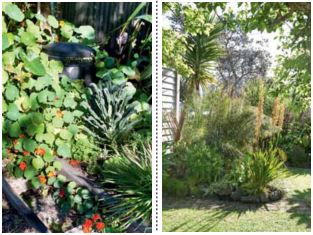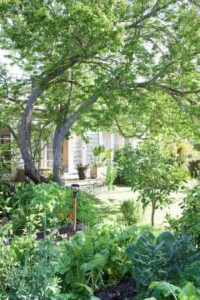Rain woman
Kirsten Sach’s rain-gardens not only purify water before it enters the stormwater system, they also enhance the lives of the plants around them.
Kirsten Sach has had a couple of previous lives. One, as a costume standby on The Lord of the Rings film trilogy, involved working with fascinating people including renowned actors Cate Blanchett and Sir Ian McKellen. She has also worked as a glass artist. But it wasn’t until she began studying landscape design at Auckland’s Unitec that she finally found her métier.
 “I knew it was what I wanted to do as soon as I saw the course advertised online,” Kirsten recalls. “I never questioned it. I feel really lucky to be doing something I am passionate about.” Now this Auckland-based landscape designer spends more time working with plants than people, creating beautiful gardens with an emphasis on sustainability.
“I knew it was what I wanted to do as soon as I saw the course advertised online,” Kirsten recalls. “I never questioned it. I feel really lucky to be doing something I am passionate about.” Now this Auckland-based landscape designer spends more time working with plants than people, creating beautiful gardens with an emphasis on sustainability.
While studying she also rekindled her passion for gardening, which began when she was a child. “My parents had a huge vegetable garden, chickens and beehives on the roof, totally sustainable,” she says. “The neighbours thought that we were weird. My parents used biodynamic gardening methods [devised by Rudolf Steiner] but they weren’t hippies. Dad was a librarian. They still garden extensively.”
In her last year at Unitec, Kirsten and a team of fellow students created an awardwinning garden for the Ellerslie Flower Show, which demonstrated how rainwater runoff could be cleansed through the use of plants and ponds before being channelled into the stormwater system or used in the garden.

Their raingarden won gold, and the next year Kirsten designed another rain-garden for the Auckland Regional Council at the Auckland Flower Show, this one using raised
beds, and picked up a silver.
Kirsten sees each garden as unique; an opportunity to connect the house to the landscape. She provides design advice, one-off consultations and workshops for people interested in building their own rain-gardens as well as designing residential gardens for a range of different sites from inner-city courtyards to offshore islands. She works from a studio in her west Auckland home, surrounded by a lush garden filled with subtropical and native plants where she is in the process of building her own rain-garden. She also has a very productive vegetable garden and miniorchard, both fully organic.
What is a rain-garden?

Kirsten’s lush home garden in west Auckland is filled with vegetables, subtropical and native plants, and even has its own orchard
Rain-gardens are an environmentally friendly solution to coping with stormwater runoff. They collect excess rainwater that runs off hard surfaces like roofs, driveways and paved areas. In simple terms, a rain-garden is a depression in the ground that collects stormwater run-off, absorbing the water, removing contaminants, sediments and slowing down the flow before it reaches the main stormwater system. They also encourage other plants in your garden, and attract beneficial insects. They’re a sustainable way to treat the rain as nature intended.
Why do you think rain-gardens are so important?
Currently in a heavy downpour, stormwater has to be disposed of all at once and rushes off hard surfaces straight into pipes, streams and rivers, eventually arriving at our beaches. Pollutants end up in our waterways and oceans, harming
precious ecosystems. The heavy flows of water cause erosion. Rain-gardens are becoming a council requirement now in some areas, particularly new housing developments, and where extensive renovations are taking place. Several of my clients have required a rain-garden as part of their design plans, something which has often opened up some exciting new and challenging ideas that wouldn’t have been possible otherwise.
Is it easy to incorporate a rain-garden?
Rain-gardens can be as simple or as complex (and as economical or expensive) as you want them to be. If you want to build a simple garden yourself then a good way to start would be to find a naturally low-lying area within your garden where the stormwater can be channelled. Don’t locate a rain-garden in the boggy part of the garden as the moisture
in the soil could be because of a high water table. You should also avoid land that is near retaining walls. If you have sandy soil then a rain-garden may not need subdrainage and stormwater will naturally drain away, but if you have clay soil then sub-drainage or some type of overflow will be required to take care of excess water. The plants you choose
will need to handle periods of both excessive dryness and water-logged conditions. Plants that live alongside streams and estuaries are often ideal as they are naturally adapted. Always check with your local council prior to starting the installation of a rain-garden.
This article featured in Home Magazine www.homenewzealand.blogspot.com

